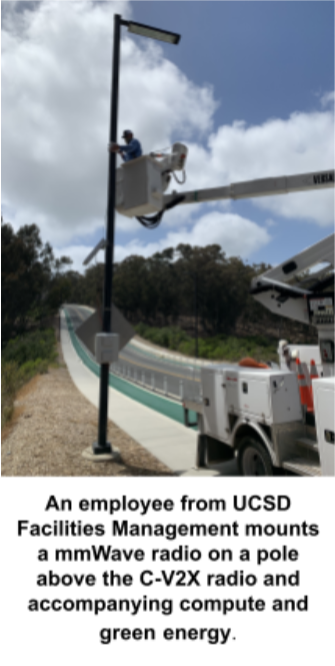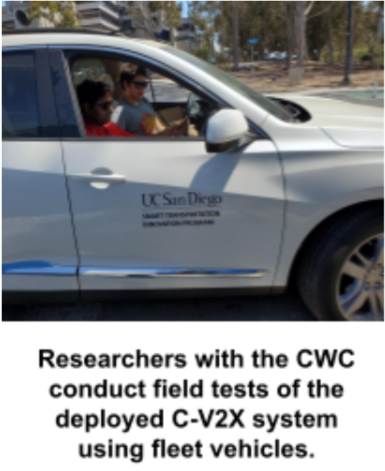Smart Transportation Testbed Made More Intelligent with C-V2X Technology
Researchers with the Center for Wireless Communications, in partnership with Qualcomm and CommSignia, deployed Cellular-Vehicle to Everything (C-V2X) equipment on the UCSD campus in June, enabling a new testbed for evaluating vehicle communications and safety technology.
C-V2X is an approach to vehicular communications that couples sidelink communications in a dedicated band with the more well-known licensed cellular bands that are commonplace today. V2X allows vehicles to communicate with both roadway infrastructure and other vehicles to share vehicle location, camera visuals, and intended vehicle actions. Installation of V2X commercial radios was part of a planned evolution of the Smart Transportation Innovation Partnership (globalstip.ucsd.edu) testbed that was created to evaluate innovations by UCSD researchers that can lead to safer, smarter, and more sustainable road experiences for all road users. The new C-V2X technology replaces a prior testbed based on software-defined radios and includes a fleet of three research vehicles, including one gifted by Honda.


The past few years have seen an exponential increase in the “intelligence” of vehicles. Propelled largely by the race to autonomy as well as advances in deep learning, new vehicles often include smart features, such as automatic braking, that are enabled by an array of sensors, such as multi-view cameras, that facilitate a vehicle’s ability to perceive the roadway environment and also monitor whether drivers are undertaking risky behavior like being inattentive to the road. Vehicular networking systems such as C-V2X are the next step for moving beyond individual intelligent vehicles to a more collective intelligence that can make roadways safer and more efficient.
The new C-V2X capability at UC San Diego will be used to showcase and refine the CWC’s advances in cooperative perception, where objects detected by multiple vehicles can be fused into a single local dynamic map with AI-enhanced offloading where data and machine learning models are distributed across a network. Cooperative perception efforts will be contrasted with ongoing mmWave V2X research (m3.ucsd.edu) to see how the two can function symbiotically as a hybrid V2X networking system. The C-V2X research team looks forward to conquering additional challenges as these technologies move out of the lab and onto the roadway.

